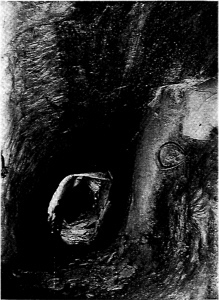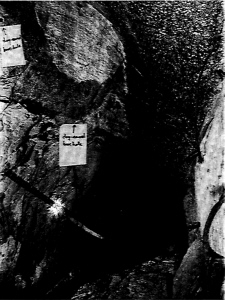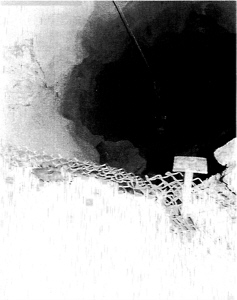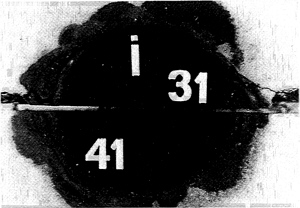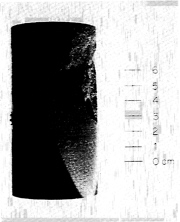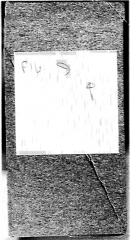2
OBSERVATIONAL EVIDENCE
There is direct observational evidence of instability in the field and in laboratory experimentation. These manifestations have been recorded in large-diameter cavities encountered in mining and civil engineering works as well as in smaller diameter petroleum applications.
Field Observations
Almost all large-diameter, accessible openings are supported in some manner to control the failure process. Rock bolts, set supports of timber, concrete or steel, steel or concrete linings, backpacked linings, and shotcrete are the principal methods of support. Once an opening is supported, the failure process may be controlled or very often is just obscured. In the worst situation, the rock failure process will create stresses that exceed the design strength of the support. It becomes imperative, therefore, that opening instability be defined before a suitable support system is designed. The flexibility of a lining and its time of placement relative to face advance are important considerations (Terzaghi, 1942; Burke and Lane, 1960; Corp and Bates, 1967; Peck and Deere, 1969; Pariseau, 1975).
The importance of an appropriate support system design and the characteristics of the failure processes have been documented. Fracture of rock adjacent to the surface of the openings has been recorded in deep excavations where the existing stress field overcame the rock strength (Leeman, 1960; Hoek, 1964; Ortlepp et al., 1972; Karwoski, 1973; Lajtai and Lajtai, 1974; Hoek and Brown, 1980) and also in cases where large deviatoric stresses have induced fracturing
(Corp, 1980; Selmer-Olsen and Broch, 1982). All of these authors observed cleavage fractures parallel to the excavation surface, and parallel to the direction of the maximum principal stress.
In the Kimberly Reef quartzite conglomerate in South Africa, enlarged geometries dominated by nominally symmetric wings have been observed in openings that are 1200 m below the surface (refer to Figure 1 through Figure 2 and Figure 3). These changes in the cross section are commonly referred to as “breakouts.” Similar types of breakout failures have occurred in the deep mine openings of the Coeur d'Alene Mining District in northern Idaho.
Figure 4 shows the breakout failures in a four-foot-diameter bored raise in the Star Mine in the Coeur d'Alene District (Corp, 1980; Beus and Chan, 1985). The severity of the fracturing diminishes as the distance from the collar increases. This is attributed to the higher stress concentrations at the intersection of the borehole and horizontal from which it was drilled. The initial breakout shown in Figure 4 may continue until the borehole is supported in some manner. The rate of boring appears to be directly related to the rate of breakout. Figure 5 shows a five-foot borehole that has broken out into an 8-ft by 14-ft ellipse at the collar. As the depth increases, the hole gradually reduces in cross section to a circular shape.
The specific characteristics of the failure of an opening have sometimes been qualitatively correlated with lithology and material strength. For example, Maury (1987) observed that curved fractures, reminiscent of shear lines, have been reported in medium to weak formations, including limestone, sandstone, and marl (refer to Figure 6). In stronger materials, such as granite, indurated sandstone, or quartzite, the observed fractures often are more or less parallel to the excavation wall and show no sign of relative displacement (slip). In these stronger media, fracture propagation parallel to the maximum principal stress and the absence of relative displacement (tensile failure has occurred) are suggestive of axial splitting seen in laboratory experimentation.
In those environments where the in-situ stress regime and the lithologic features favor shear fracturing, it is important to note that the angle of incidence between a representative fracture and the wall of the opening seems to be much less than what would be predicted by the plasticity theory (logarithmic spirals). However, since precise measurement of the spatial characteristics of such fractures is complicated, it is difficult to draw definite conclusions from this observation. Furthermore, in practice, the conjugate shear lines intersect the wall at two points away from the point of maximum stress concentration, symmetrically with respect to the opening diameter.
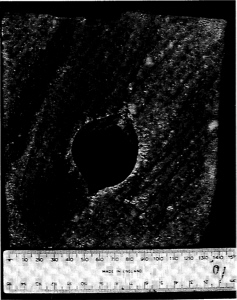
Figure 3. Detail of the top left-hand corner of Figure 2. Note “scrubbed” appearance of the terminal surface of the microslabbed, buckling end of the extension fractures. Note repetition of the extension slab buckling on a microscale in the dog-eared borehole. This borehole has almost the same orientation of “dog-ears” (breakout) as the second hole in Figure 2. [Photograph courtesy of W. D. Ortlepp, Anglo American Corporation.]
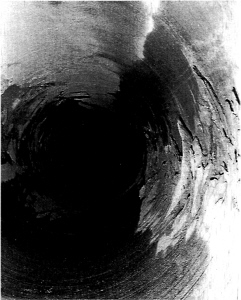
Figure 4. Breakout failures in the vertical hole extending between the 7,020 and 7,200 levels of the Star Mine (sv = 7,280 psi, sHMAX = 10,430 psi, sHMIN = 6,880 psi, sHMAX acting parallel to the fracture cleavage in steeply dipping, interbedded, fine-grained quartzite and argillite, 12,300 psi < C0 < 42,000 psi, 1,200 psi < T0 < 3,800 psi). [Photograph courtesy of E. Corp, U.S. Bureau of Mines.]
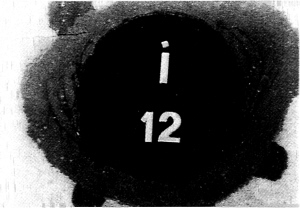
Figure 6. Curved fractures in the vicinity of a circular hole, observed in laboratory testing. [Photograph courtesy of A. Guenot, Elf-Aquitaine.]
The slabs bounded by these fractures are almost intact and are not disaggregated. Therefore, it seems that a rupture may be initiated at a small distance (several percent), relative to the opening dimensions, away from the wall, and propagates toward the free surface.
Explanations for such behavior could include nonlinearity as a consequence of stress-dependent elastic properties (Santarelli and Brown, 1987) or poroelastic effects (Roegiers and Detournay, 1988).
Ruptures around underground circular openings also often exhibit a periodicity (Figure 4). This seems to be particularly true in the case of hard rock and may support the concept of fracture initiation away from the wall, as it could correspond to simultaneous initiation points with fracture coalescence.
In a similar fashion, it has been reported that during tunnel excavation in hard rock, fractured and intact zones are alternately encountered. The intact zones have often developed delayed failures. This was the case in the Mont Blanc Tunnel between France and Italy. It is difficult to establish whether the fractured zones are natural or are a consequence of the tunnel advance and mining conditions. Experience in deep South African mines apparently has verified the latter hypothesis.
The foregoing examples and other literature reflect situations where observed features cannot readily be rationalized on the basis of the current state of the art. Maury (1987) offered two additional examples. Abnormal stability was encountered in an underground storage gallery in chalk, where no visible signs of rupture and no microcracking (as determined from the velocity and Schmidt hammer measurements) could be detected. Despite such indications of integrity, the actual stress level in the lateral wall (measured with flatjacks) was equal to the value of the uniaxial strength. Moreover, lateral coring indicated stress concentrations equal to two times the uniaxial compressive strength. The second example was for water tunnels excavated in shallow siltstones. The walls of these tunnels apparently had been subjected to stress levels which were two to three times the value of the uniaxial strength with no indication of failure or distress.
There are other published examples indicating the requirement for progressive thinking and detailed modeling. Consider the comprehensive field testing in a 20-ft-diameter circular shaft in the Coeur d' Alene Mining District (McKinstry, 1983; Beus and Board, 1984, 1989). As an example, in the Silver Shaft, measurements were made of rock displacement and support loads (concrete stress and strain) at four shatft depths, ranging from 735 to 1,827 m. The authors found that many factors affect the displacements and ultimate stability of both the shaft wall rock and the shaft liner. Foremost among these are the magnitude and ratio between the horizontal principal stresses, extent of geological discontinuity and rock-mass anisotropy, time lag between excavation and support installation, and influence of intersections into the primary opening, such as shaft stations and loading pockets. Analysis of the field data, using displacement discontinuity approaches developed by Cundall (1983) and an elastic, no-slip, rock-support interaction approach, developed by Detournay (1983), bracketed the
measured data well and verified that the shaft and support system responded to the high deviatoric stress component in an expected manner. Further work by Beus and Dar (1989), using a 3D finite element approach, verified the influence of rock-mass anisotropy, as well as the effect of face advance and intersections.
These observations substantiate the necessity for sophisticated modeling and for invoking considerations beyond established linear elastic formulations to rationalize excavation stability. Even so, situations are reported where anomalies are encountered. For example, in underground mining, the openings are very often subjected to a changing stress field caused by the excavation of nearby openings. What was once a stable opening (supported or unsupported) can now become very unstable. A good example is in block-cave mining where a development opening is mined in virgin ground and lined with concrete. The major principal stress acts in a vertical direction. Then, the ore body is undercut by a series of slices, the vertical component of stress is removed, and the horizontal component increases. This causes a reversal of the stresses acting on the opening and the lining. As the ore body begins to cave into the undercut area, high vertical stresses again are imposed and the lining stresses again are reversed. These stress reversals can cause cracking and failure of the lining (Panek, 1981; McLaughlin et al., 1983). Simulation of the complete stress history is evidently essential to accurately predict the opening response.
As another example, the stability of a shaft during excavation of a nearby high-grade ore pillar was reported by Johnson and Poad (1989). Instabilities were noted in the shaft in areas where detailed numerical modeling predicts a highly stable condition.
Another poorly understood cause of instability in underground openings is discussed by Dutro and Patrick (1982) in their analysis of the 2560-m long Straight Creek Tunnel pilot bore. The phenomena, referred to as transients, are generated when an advancing tunnel face intersects identifiable geologic discontinuities. These transients, apparently propagating as strain waves, could be detected for many hundreds of meters along the tunnel and have an effect on the rock/support equilibrium. Other evidence suggests that man-made discontinuities (portals, cross-headings, etc.) initiate similar transients that can propagate over thousands of meters. Beus (1973) noted, for instance, transients while instrumenting a section of the 10-mile-long Henderson Mine Tunnel through the Continental Divide in Colorado.
The civil and mining situations described above are complemented by experience in the petroleum industry. Stability problems have been encountered in soft shale/clay, more or less hard shale, lime-
stone/dolomite, flysch (interbedded shale and sandstone), granite or eruptive rock, evaporites, coal, etc. However, there are no strict lithologic rules. For example, although there have been relatively few reported drilling and stability problems in moderately cohesive sandstones, there are examples when drilling in unconsolidated sandstones has also proceeded without difficulty. A case in point is a horizontal well drilled in a completely unconsolidated sandy reservoir in the Chateaurenard field in the Paris basin. There are also examples of stable wellbores in chalk. On the other hand, there are reported situations where very hard formations, such as eruptive intrusions in softer sedimentary rocks, have led to substantial stability problems. These observations merely emphasize the importance of the in-situ stress field in conjunction with the material's strength characteristics, and highlight the risk of arbitrarily correlating the stability with lithology.
With the exception of salt and very soft shales, most of the failures documented in the oil and gas literature seem to be brittle. This has been substantiated by the character of the debris on shale-shaker screens. In the reported cases, this is to a certain extent surprising when one considers that it is evidenced in shales which originate from depths where the mud pressure may exceed 40 MPa. The shape of the debris is reminiscent of the shape of slabs in larger tunnels. The brittle character of the failure at a substantial depth simply highlights the importance of an appropriate failure relationship involving effective stresses. This is well illustrated by Steiger (1989).
Complex fracture patterns have been hypothesized and reported in mud-filled wellbores. Maury and Sauzay (1987) suggested that toric-shaped fractures are possible when the axial stress is the maximum stress component. Such failure morphology has been reproduced in the laboratory (Périé and Goodman, 1989) and observed at the Camborne School of Mines Geothermal Energy Project. Those failures, as predicted by theory, occurred in the direction of the maximum horizontal stress.
Direct observation of the instability is supplemented with numerous examples in the drilling literature of stuck drillpipe due to localized inward movement.
As in the context of the civil and mining structures, a paramount influence on the stability in oilfield drilling is the relative orientation of the wellbore with respect to the directionality of the principal stresses. Accelerated industry trends for drilling high-angle and deviated wells place special emphasis on this issue. An early perception of the pertinent issues was provided by Bradley in 1979. Documented information is scarce. One example of relevance is for three
horizontal wells recently completed in a field offshore of The Netherlands. One of the wells, oriented perpendicular to the others, encountered far fewer problems while drilling through a shaly sequence than did the other two wells. This is also often the case when developing a mine and pillar operation.
Wellbore failure has been attributed to chemomechanical alteration, particularly in smectitic shales, to shear failure, and to unintentional hydraulic fracturing. The drilling literature offers numerous examples of inferred hydraulic fracturing as evidenced by spontaneous lost circulation. Validation is sometimes difficult. For example, there are circumstances where an induced fracture has been identified from microcaliper logging, although no discernible mud loss had occurred.
Laboratory Observations
Field observations on circular openings of varying scale have highlighted the complex interrelationship between the stress field (either static or transient), geometry of the opening (radius and time dependence), and in-situ material characteristics (strength, anisotropy, discontinuities, etc.). Laboratory experimentation has been performed to define the fundamental behavior, validate theoretical and numerical models, and discriminate between the relative influence of stress levels and material characteristics associated with the response of a circular opening.
Experiments have been performed on plates containing a central circular hole loaded either uniaxially (Abel and Lee, 1973; Rummel, 1975; Worotnicki and Denham, 1976; Kennedy and Lindberg, 1978; Mohring-Erdmann, 1982) or biaxially (Casarin and Mair, 1981; Dhar et al., 1981; Kaiser and Morgenstern, 1981, 1982; Mastin 1984; Kaiser et al., 1985). In these 2D situations, under very high loading conditions, most experimentalists report a series of curved fracture planes, resembling logarithmic spiral slip lines, apparently tangent, at every point, to the shear direction at that point. Some investigations have been conducted using large blocks to assess the 3D character of the failure surfaces (Daemen and Fairhurst, 1972; Stillborg et al., 1979; Mizuta and Kobayashi, 1980; Bandis and Barton, 1986; Bandis et al., 1986). In general, specimens in these investigations were loaded until it was obvious that a fractured zone had developed around the circular opening perimeter. Zones of compaction were limited, with the attendant inference that load transfer occurred, absorbing a percentage of the stresses predicted to exist on the basis of the elastic theory.
The inadequacy of strictly elastic considerations has been emphasized by authors who monitored stress changes during drilling (Kanda et al., 1981; Bandis et al., 1986; Mohring-Erdmann and Rummel, 1987) using embedded miniature pressure cells. These tests tended to establish that the circumferential strain reached the nonlinear regime at relatively low stress levels, but that it decayed toward a linear elastic regime over a relatively short radial distance (r = 2a). Radial strain behavior was found to be more complex, showing significant inelastic dilation near the borehole wall (r = 1.2a), switching to substantial radial compaction (until r = 2.5a), and returning to an elastic regime at still a larger radial distance from the borehole. These experimentalists measured
-
radial inward movements far in excess of what could be predicted from elastic considerations alone;
-
a fractured zone at collapse, which did not have the extent predicted by elastoplastic numerical simulations; and,
-
an increase in the longitudinal stress (i.e., along the borehole axis) of approximately 25%. This was attributed to dilation. This stress component apparently played an important stabilizing role.
Further experiments on thick-walled hollow cylinders of Berea sandstone and Indiana limestone incorporated additional features plane strain loading (zero axial deformation), the ability to impose different stress paths on the rock using independently controlled pressures on the inner and outer diameters, and preservation of the fracture geometry under load using a metal saturation technique (Ewy et al., 1988a). In these tests, failure was induced around the hole by subjecting the specimens to high axisymmetric pressure on the outer diameter and low or zero effective pressure in the hole. Measurements of the elastic deformations (i.e., fully recoverable) substantiated that these hollow cylinders did not behave as homogeneous linear elastic solids, even when a confining or mean pressure-dependent modulus was introduced. Measurements of deformations during failure indicated that the rock immediately next to the borehole wall begins to fail at an applied load two to three times greater than would be expected from a comparison with the theoretical elastic stress concentrations. This is consistent with other field and laboratory observations, as indicated previously. Guenot (1987) summarized a series of tests where the ratio between the actual load at rupture and the theoretical load, determined using elastic limit models, was between 1.5 and 4, with some extreme values such as 8 for a marble.
There are other uncertainties in comprehending the behavior of circular openings. Haimson and Herrick (1989) reported a definite strengthening effect with decreasing hole size. This is an anticipated effect in geotechnical engineering and has been documented for other applications. In terms of breakdown pressure for hydraulic fracturing, it was established analytically by Cleary et al. (1979) and experimentally described for hollow cylinder loading by Robertson (1955), Bellamy (1960), Durelli and Parks (1962), Hobbs (1962), and Jaeger and Hoskins (1966). These authors highlighted the importance of high stress gradients. Other factors of importance influencing the strength of circular openings include the influence of the intermediate principal stress (Adams, 1912; Robertson, 1955; Hobbs, 1962; Obert and Stephenson, 1965; Jaeger and Hoskins, 1966), restriction of dilatational expansion to only one direction, and anisotropy.
These uncertainties are emphasized by other observations. The basic importance of anisotopy has been clearly indicated by Komar and Frohne (1973) and by Haimson and Edl (1972). As another illustration, Ewy et al. (1988b) performed testing where, although the loading was axisymmetric, failure occurred on two diametrically opposed sides of the hole with an azimuth consistently oriented among the different tests for the same lithologic zone. Oriented Brazilian compression tests determined that the failure location was controlled by rock strength anisotropy, with failure occurring where the tangential stress around the hole was parallel to the bedding plane, corresponding to the weakest direction in compressive loading. In all samples, the hole closure measured along the failed diameter was significantly greater than that measured along the perpendicular (unfailed) diameter, suggesting significant dilation in the failed material. The role of anisotropy, discontinuities, and “imperfections” will undoubtedly play an even stronger role in engineering situations outside of a controlled laboratory environment. Ewy et al. (1988a) suggested that the extent of failure may be influenced by the stress state at which failure begins, and therefore by the stress path leading to failure and possibly by the strain rate.
Classic illustrations of the importance of strain rate are the so-called Ruesch envelope for concrete, and the internal pressurization of wellbores. The hydraulic fracturing literature is replete with examples, many already cited in this document. The morphology of the fracture system created by hydraulic fracturing is substantially different from that which is a consequence of blasting or tailored pulse loading. However, in the experiments described by Ewy et al. (1988a), regardless of the stress path or strain rate, the same general pattern of failure was evident in all samples. On the basis of microscopic
examination, Ewy and Cook (1989) reported the initiation and growth of small, opening mode splitting cracks, oriented parallel to the tangential stress around the opening. Beginning very close to the hole wall, the fracturing progressed deeper into the rock with increasing stress. Numerical modeling of splitting cracks, next to stressed circular openings, indicated a size effect on the strength and confirmed preferential growth proximal to the surface of the opening. Figure 7, from the experimental work of Guenot (1989), is a graphic illustration of the mechanisms involved.
With zero effective stress in the hole (no support), these cracks have been reported to coalesce to form macroscopic splitting fractures at a fairly uniform spacing oriented parallel to the free surface, and also form en échelon patterns which approach and meet the free surface, combining to define the outline of a spalled piece. These spalled pieces progressively form and detach from the surrounding rock. The failed zones extend deeper into the rock, eventually stabilizing with a roughly triangular shape and pointed tip (Ewy et al., 1988a; Ewy and Cook, 1989). Numerical modeling by Zheng et al. (1989) predicted such finite rock chips, indicating that stabilization resulted from the nature of the elastic stress distribution around the final shape. With a small support pressure in the hole (5 to 10 MPa effective stress), the rock around the hole is greatly strengthened and stabilized. Macroscopic splitting features, and therefore detached spalled pieces, do not form and hole closure along the failed diameter is less than in samples with zero support pressure in the hole. Localized damage features do form. These localizations of cracked and crushed grains are oriented similarly to logarithmic spirals in a Coulomb material, although they do not follow the predicted path exactly. In spite of such damage, the material still has significant cohesion.2 This behavior, both the increased strength and morphology of failure, is completely consistent with conventional thinking. Consider the analog of uniaxial vs. triaxial compression testing shown in Figure 8 and Figure 9 from Labuz et al. (1988).
|
2 |
Analytical models confirm that a small confining (i.e., radial) stress greatly inhibits the growth and in-line coalescence of splitting cracks, allowing other processes (i.e., shear localization) to dominate (Kemeny and Cook, 1987). |

